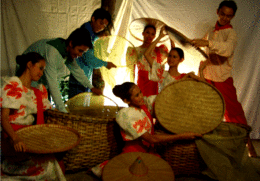Radio in the Philippines
| Part of a series on the |
| Culture of the Philippines |
|---|
 |
| History |
| People |
| Languages |
| Traditions |
| Cuisine |
| Festivals |
| Religion |
| Art |
| Literature |
|
Music and performing arts |
|
Monuments |
|
Radio in the Philippines started in 1924 with establishment of KZKZ (AM) in Manila, Philippines by Henry Herman Sr., owner of the Electrical Supply Company in Manila. Henry Herman was an American and a former soldier who came to the Philippines to fight in the Philippine–American War.[1] He stayed in the Philippines after he was discharged.[1]
This was not the first test however. Archives suggest that an American woman named Mrs. Redgrave used a five-watt transmitter for a test broadcast from Nichols Field (now Villamor Airbase).[2] This test is possibly the first radio broadcast in Asia.[2]
Henry Herman's station originally broadcast using a 5-watt transmitter. In 1924, it boosted its power to 100 watts. In 1924, Radio Corporation of the Philippines bought KZKZ AM from Henry Hermann.[2] In 1926 the company began to work on constructing two of the largest radio stations in Asia with the idea of maintaining direct Manila-San Francisco service.[3] After Philippine independence, it changed its callsign to DWKZ, but changed in 1960 to DZCA.[4]
In 1929, RCP launched KZRC in Cebu broadcasting with a 100-watt transmitter, but was later sold to store owner Isaac Beck. It is now DYRC owned by the Manila Broadcasting Company.[2]
Early on, all radio programs were in English.[2] This was the American Colonial Era in the Philippines. Most shows resembled American shows, even copying sponsorship.[2]
Radio was unregulated until 1931 when the Radio Control Board was established under the Insular Government.[2]
The current oldest radio station is DZRH.
See also
References
- 1 2 Herman, Harry E. My Father's Plight with the American Eagle http://harryeherman.com/. Retrieved 19 October 2015. Missing or empty
|title=(help) - 1 2 3 4 5 6 7 "History of Philippine Radio". Radio Online Now. Retrieved 19 October 2015.
- ↑ Time Magazine, September 20, 1926
- ↑ www.oldradio.com